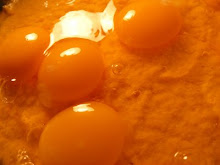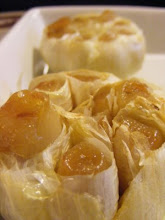I had a customer ask me to make a roasted red pepper and asparagus bisque the other day. What is a bisque, you say? Well, the classic definition is "a thick, creamy, highly-seasoned soup of French origin, classically of pureed crustaceans." However, a vegetable bisque is not made of crustaceans. It is simply a thickened puree of vegetable. Why then is it called a bisque? I guess it sounds much more elegant than "cream of vegetable." Regardless of the terminology, I was asked to produce the roasted red pepper and asparagus bisque so I obliged.
Now, in my opinion, the flavor of the roasted red peppers would have overpowered the subtle flavor of the asparagus. Asparagus has a mild flavor in comparison to red capsicums. So, I elected to make two separate soups and serve them in the same bowl.
Furthermore, I decided to take the flavors in two different yet complimentary directions. The red pepper soup was sweetened with a little sugar in order to enhance the sweetness of the peppers, and the asparagus soup was lifted with a little lemon juice to give it a bit of acidity.
Now, in my opinion, the flavor of the roasted red peppers would have overpowered the subtle flavor of the asparagus. Asparagus has a mild flavor in comparison to red capsicums. So, I elected to make two separate soups and serve them in the same bowl.
Furthermore, I decided to take the flavors in two different yet complimentary directions. The red pepper soup was sweetened with a little sugar in order to enhance the sweetness of the peppers, and the asparagus soup was lifted with a little lemon juice to give it a bit of acidity.
 All of this analysis is hot air I suppose, but I wanted the two soups to have a taste very distinct from one another. This was important considering that they were being served in the same bowl, and spoon for spoon, they had to be distinct and complimentary. Not only did the tastes have to be complimentary, the colors had to be complimentary as well. Green and orange are complimentary colors on the color wheel so they were perfect for one another. You see...interior design principles at work in the kitchen!!
All of this analysis is hot air I suppose, but I wanted the two soups to have a taste very distinct from one another. This was important considering that they were being served in the same bowl, and spoon for spoon, they had to be distinct and complimentary. Not only did the tastes have to be complimentary, the colors had to be complimentary as well. Green and orange are complimentary colors on the color wheel so they were perfect for one another. You see...interior design principles at work in the kitchen!! In dealing with the asparagus soup, it was important to remember that the chlorophyl is destroyed by heat. This means that if you overheat a soup (or vegetable for that matter) that is green, it will lose its brilliant color. So in order to dazzle the eye with a nice flash of green, the soup was heated until the asparagus was just el dente and then it was pureed immediately and cooled rapidly in an ice bath. As you can see, the color is good!
In dealing with the asparagus soup, it was important to remember that the chlorophyl is destroyed by heat. This means that if you overheat a soup (or vegetable for that matter) that is green, it will lose its brilliant color. So in order to dazzle the eye with a nice flash of green, the soup was heated until the asparagus was just el dente and then it was pureed immediately and cooled rapidly in an ice bath. As you can see, the color is good!
Both soups were thickened only with the vegetables and aromatics they were made with; there were no thickeners used. I wanted the simple, clean flavors of the vegetables to shine through with as little competition as possible. Also, thickeners tend to "muddy" things up a bit. So, the soups were pureed in a high speed blender until super smooth and frothy and the consistencies were adjusted with stock. Then they were seasoned and finished with a bit of whipping cream.
So, in cooking these soups, I kept things simple really. The vegetables speak for themselves and were treated with respect for their unique characteristics and flavors. A lot of talk about something so elementary, but the basics are the building blocks of fine cooking and what can be more basic than making soups from fresh vegetables? Peeling potatoes I suppose!
So, in cooking these soups, I kept things simple really. The vegetables speak for themselves and were treated with respect for their unique characteristics and flavors. A lot of talk about something so elementary, but the basics are the building blocks of fine cooking and what can be more basic than making soups from fresh vegetables? Peeling potatoes I suppose!











































































4 comments:
That looks so delightful!! Mmmm
Plus, you called it a red capsicum... I was floored when I heard that term here in Australia.. they think a red pepper is just obsanity! He he! I remember the first time I went to Subway here (my first meal in Australia) and asked for Green Pepper and got the wildest reaction! I understand it to be capsicum now!
It's a botanical term.
What are aromatics? Are they spices? If so, what spices did you use for this soup?
-Thank you.
Aromatics are the flavor builders in a soup. In many cases we add ingredients such as onion, leek, celery, carrot and garlic to a soup as well as the primary ingredients (say, chicken, noodles and other vegetables in chicken noodle soup)to build flavors.
In French cooking, the aromatics are known as "mirepoix" which is a blend of onion, leek, carrot and celery. It is the backbone of French cuisine.
In these two soups, no spices were used. Fresh herbs were pureed into the soups in the blender after they were cooked.
Marko
Post a Comment